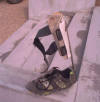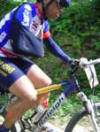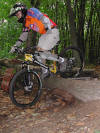Mountain Bike Amputee does not charge or collect
membership fees and does not manufacture or sell products or
services. PLEASE NOTE: Mountain biking and cycling have
inherent risks. Always wear appropriate protective gear and ride
within your comfort zone and ability.
On August 21, 2021 Victor Walther Passed Away.
As the website manager, I will do my best to keep this website
active, in Victor's Memory
|
|
|
This Page was included to allow non amputee
cyclists and mountain bikers suffering from various disabilities or
injuries to share their information and experiences. This page is also
intended to allow able bodied mountain bikers and cyclists to share their
knowledge on equipment and
riding skills and technique.
I would like to offer the following tips to anyone suffering from a
weak or diminished grip, and that is, to use hydraulic disc brakes and
Shimano Rapid Fire shifters. Hydraulic brakes offer one finger stopping
power while the Shimano Rapid Fire shifters are the most ergonomic
friendly and easy to operate.
The following contribution was made by Randy Hanson.
Randy is an avid cyclist both on and off road who suffers
from chronic tendonitis. He has some great advice for anyone suffering
from a weak or diminished grip.
Here is what Randy has to say:
I have chronic tendonitis in my wrists. Before I got Hayes disc brakes I had to stop on any significant downhill to let my forearms
un-cramp. A small change like that can make a big difference to riders with physical limitations.
I also had a similar problem on down-hills on my road bike -- I replaced the handlebars with the anatomical handlebars which eliminates the bend in my wrists while on the drops and replaced the Shimano RSX brakes with the Shimano Ultegra brakes which have a metal
backing to the brake pad and much superior braking performance. These changes have really helped on my road bike. I would still like to get discs for my road bike, I think it can be done but I haven't really investigated it.
Ride On!
Randy www.iron-horse.us/mtb
|
|
0==0==0==0==0
The following contribution was made by Doug Owen who is an USAC
certified coach.
Hello:
I have joined the growing group of cyclist with a prosthetic. I am
among of the fortunate ones in that mine is limited to a fully
functional cobalt, titanium and plastic knee. I had my total knee
replacement done in November 2009. I have found that I can once
again ride and have found that I now have a new avenue to reach out
and help others who are adjusting to artificial parts on their body.
Over the past 10 years I have been featured many times in the
Arthritis Foundation publications. I look forward to making contact
with others and hopefully help people to understand that "obstacles
are really opportunities."
Thanks,
Doug
Doug Owen USAC certified coach USAC certified official Cycle 4 Life
Bike Shop Banner Elk, NC 28604
828-898-5445
828-387-1114
www.cycle4lifebikeshop.com
0==0==0==0==0
The following comments were taken from an email from
Michael Maier, who lost the feeling in his left leg after breaking his
back.
Michael was able to recover most of the function of his
leg with the exception of his calf muscle, attributing cycling as a major
part of his recovery.
Here, in part, are some of his comments:
I broke my back some years ago and lost the feeling in my left
leg, completely pelagic. Over the years I have been able to restore much
with bike being a major part of that. One problem I had was my calf muscle is
still completely pelagic. I don't have any hope for it coming
back, its been 10 years. I can ride ok but my foot collapses onto my
ankle it causes severe pain in my ankle. So I built a brace. (see
picture) I have done some variations since this picture was taken. Since I
don't use my knee brace anymore I cut it into two and
replaced that white shin guard with the lower halve of my knee brace. That
looks better and seems to work ok but would like help building this better
and lighter. The idea works great. I can stand up and pedal now and going
down hill dose not hurt so bad. There are quite a few people with this
problem . I broke my back but many other people lose control in there legs
because of diabetes or car accidents. Bad circulation happens and can
lead to loss of feeling.
|
News & Events
|
Recovering from my broken back I had all kind of braces. After
seeing how many times it took the "professionals" to fit me
with my knee and back brace I thought I would take a whack at my own
foot brace. I took a digital picture of my foot while pedaling my bike.
I then imported that picture into AutoCAD and measured the angle and
distances. The shoe has a stainless steel shank and the brace bolts
to that. It keeps my ankle from collapsing while riding. For the
first time I could stand up and pedal up a hill.
Click on pictures to enlarge.


0==0==0==0==0
Dan Mead along with fellow Prosthetist Bill Buston, have
come up with a hinged crank arm that allows leg amputees and those
suffering from limited range of movement in their knee to pedal. For more
information visit The Hinged
Crank Arm.
0==0==0==0==0
The following pictures were taken and submitted by Dax Jaikel (who is
featured on the Leg Amputees page) at the
2003 La Ruta de Los Conquistadores endurance race. The pictures are of
Carlos Valerio from Costa Rica.
Carlos had his right arm seriously injured after being hit by a car
while training for a triathlon.




0==0==0==0==0
The following pictures are of Ky Nam Tran who lost the
use of his left arm due to a motorcycle accident. Despite his injury, Ky
Nam has put together an impressive website that provides inspiration and
encouragement along with some great mountain biking pictures. If you would
like more information on Ky Nam visit: http://b2r.free.fr?lang=1


0==0==0==0==0
The following suggestion was contributed by Tobias
Bachmann
Hi guys
I'm impressed! Very impressed! What you do to
be able to ride a mountain bike is unbelievable! But why do you use two shifters? Maybe you
have already heard of Rohloff hubs. These hubs have 14 gears witch covers the same range as 3 x
9speed. The big advantage is that you have one grip shifter for all 14 gears.
Maybe it helps to give you an even better bike
experience.
For more info visit www.rohloffusa.com
or you can email Tobias at tobias.bachmann@helbling.ch
0==0==0==0==0
The following contribution was made by Ricardo Rueda.
Dear sirs,
A few days ago I met this guy who invented this double traction bike and thought it might help some amputees. Take a look at the
video link:
Double Traction 2x2 Bicycle
Cheers,
Ricardo Rueda.
PS: I think the website is not very clear telling how does it work, but the upper part of the fork swings a little bit and thatís how traction gets to the front wheel.
0==0==0==0==0
The following suggestion was contributed by Kevin Smits:
My
name is Kevin Smits and I represent a company called Rotor Systems. We have designed a crankset for bicycles that eliminates the dead spot in
your pedaling stroke. One does not need to spin our cranks in order to utilize
the entire pedaling stroke resulting in less knee fatigue, greater speed
with less effort and the ability to climb with ease. This is done by
accelerating the recovery crank arm so that when one crank arm approaches
the 6 o'clock position the other crank arm is already at 1 o'clock.
Constant power to the pedal Info:
www.rotorbike.com
If
this is of any interest to you,
p
lease email Gary Tingley at gary@rotorcranksusa.com
or visit
Gary
ís website at www.rotorcranksusa.com,
or call
Gary
at (619) 335-0180.
Below is an email that I received from Joe Sapere who is the head of
Amputees Across America, a group dedicated to getting amputees out and
active, similar to your organization. Every year they ride bikes across
America visiting hospitals and sky diving in various spots along the way.
A fun group!
Reply to my first email:
"Your product is an answer to my prayers. Amputees cannot stand
up on the
pedals because they do not have the toe flexion to get the pedal past the
TDC of the rotation. Your product would overcome this and be a boon
to the
amputee rider."
Reply after trying the Rotors for the first time"
"I know I was to ride a week or so and THEN call you with what I
think of the Rotor Cranks, but I would rather not wait till then. I
had it put on and picked up the bike from the shop yesterday. From
the start, it felt just like a normal pedal stoke. It felt the same
as always so I was wondering if maybe the cranks were not working.
Then I stood up on the pedals. Oh yes, it was working. For the
first time since my amputation in 2000, I was able to stand on the pedals
and pedal. Unbelievable! I couldn't wait to find a hill to do
a standing climb. Well, I did and the rest was history. Things
are working so well, I don't even want to try any other regulation point
than 3 because it just can't be any better than this.
As I could barely contain my exuberance, I have put it on the first page
of my website. You may check it at
Amputees-Across-America.
As you may notice, I did not provide a link to your website because I want
all the amputees who read it to hear my story (and maybe even mention my
name when they order theirs). Now I will just have to figure out how
I can equip the recumbent I am ordering next month and the bikes of the
three riders each year.
To say I am pleased would be an understatement. I called the guys
from last year's ride and they probably think I have gone bonkers.
They will sing a different tune when I pass them on a hill and when I
stand to sprint."
0==0==0==0==0
Dear mtb-amputee, As an avid mtb rider I somehow came
across the site. Some great stories and inspiration there. Iím lucky not
to be disabled but I always have concerns about injury and longevity (I
want to mtb when Iím 80!)
I came across this damping devise called the Hopey Damper, a device that
gives more control to the handlebars. Iíve never used the device but it
has excellent reviews on MTBR, and I reckon that for one handed riders
it would be a huge benefit.
Hopey Steering Damper
From what I understand the device stiffens up steering and holds the
bike straight easier. When you do steer itís easy enough, but just makes
it more controlled. It basically takes out all of the steering chatter.
From the site: With the hopey bicycle steering damper, Downhill racers
experience enhanced stability, improved cornering, and a far less
fatiguing ride. This is because the steering damper absorbs the hits
that throw the bike off line. XC riders and Roadies share the same
benefits, plus, find that the damper helps with climbing. Technical
climbs are easier, you hold your line and won't need to step off as
often. Power climbs are more efficient, since more or your energy input
is directed straight forward.
The damper is not cheap but I thought it might be worth it to get Tim
Hopeys' (the inventors) thoughts on using it for on handed riding. If it
as beneficial as Iím thinking a lot of your readers might be interested,
and who knows? Perhaps they might even provide a discount for your
readers too.
Update: I started this message a while ago but decided
to ask Tim Hopey about it the benefits for disabled riders. Here is what
he said:
Yes, the hopey offers a huge benefit for the disabled
rider. A bike is designed to stand up and go straight when it is moving.
That is what the rake and trail of the front end is doing for you. That
is why ďonce you learn to ride a bike youíll never forgetĒ because
subconsciously you figured out how to let the bike do the work. Your
hands are on the handlebars to mostly keep the bike controlled and
straight. Most corners are executed by leaning the bike, not turning the
bars as much as you think. Your bike wants to go straight, you want it
to go straight. The hopey assists in keeping the bars straight.
In rough terrain, there are all sorts of things knocking you off line,
the hopey is doing the work for you, keeping you on line.
We have sold a lot of hopeys to amputees and the injured. All are very
satisfied. I remember a disabled Olympic guy using one, couldnít ride
without, road bikes I think.
Hope that helps, hopey
Jesse Kelly
www.creativearts.com (Coming Soon)
267 934 1676
0==0==0==0==0
The following suggestions were contributed by Alan
Roberts who has 20+ years of technical/medical fabricating experience and
has been riding bikes off-road long before they started calling them
'mountain bikes'. Alan recommends visiting the following websites which
contain information on para-handcycles and a company that produces the
'mountain drive' bottom bracket gear reductions which could be very
helpful for leg amputees. http://www.titaniumarts.com/content/handcycles/photos.html
& http://www.schlumpf.ch/md_engl.htm
0==0==0==0==0
If you or anyone you know could benefit from, or would like to
participate on this website, email your enquiries or pictures and
information to: mtb-amputee@mtb-amputee.com
Stay tuned for future updates and additions.
|







